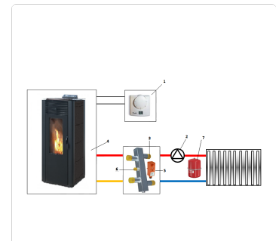
Are you considering switching to a pellet stove for your home? With rising energy costs and increasing interest in sustainable heating options, pellet stoves are becoming a popular choice among homeowners. But is it the right solution for you? This article explores the key benefits, considerations, and statistics surrounding pellet stove to help you make an informed decision.
What Is a Pellet Stove?
A pellet stove (pelletkachel) is a heating device that burns compressed wood or biomass pellets to generate warmth. These stoves are known for their efficiency and environmentally friendly design. They are often used as a primary or supplementary heating source for homes.
Pellets, the fuel source, are made from recycled sawdust, wood chips, and agricultural waste, making them a more sustainable option compared to traditional firewood or fossil fuels.
Why Choose a Pellet Stove?
1. Energy Efficiency
Pellet stoves boast an impressive efficiency rating, with most models achieving efficiency levels ranging from 70% to 90%. This means they convert a significant portion of their fuel into usable heat, making them an economical choice for homeowners. Additionally, they produce fewer emissions compared to wood-burning stoves, contributing to cleaner indoor air quality and a reduced carbon footprint.
2. Cost-Effectiveness
One of the key reasons people turn to pellet stoves is their cost-effectiveness. Depending on pellet prices in your area, heating with pellets can be cheaper than propane, oil, or electric heating systems. On average, households will spend between $200 to $500 annually on pellets, depending on usage and local fuel costs.
3. Convenience of Use
Unlike traditional wood stoves, pellet stoves are loaded with automated features. Some advanced models come with thermostats and timers, allowing you to set your desired heating schedule. Additionally, pellet hoppers can store fuel for several days, reducing the frequency of refills.
4. Eco-Friendliness
Pellets are a renewable energy source, and their combustion emits fewer greenhouse gases compared to nonrenewable heating fuels. Since the pellets are made from recycled materials, their production minimizes waste.
5. Zone Heating
Pellet stoves are ideal for zone heating, which allows you to target specific areas of your home and reduce energy costs associated with heating unused spaces.
What to Consider Before Buying a Pellet Stove
1. Initial Investment
Though pellet stoves are cost-effective in the long run, the initial investment can be significant. The cost of a pellet stove typically ranges from $1,500 to $3,000, depending on the size and features you choose. Additionally, there may be installation costs to factor in.
2. Maintenance Requirements
To keep your pellet stove running efficiently, regular maintenance is essential. This includes emptying the ash pan, cleaning the hopper, and removing any build-up from the burnpot. Scheduling an annual professional inspection is also recommended.
3. Fuel Availability
Check the availability of pellet fuel in your area. While pellets are widely accessible in most regions, their cost and availability can vary, especially during the winter months.
4. Space Requirements
Pellet stoves require proper placement and ventilation. You’ll need to designate a safe spot in your home and ensure adequate venting is installed to expel emissions.
The Bottom Line
A pellet stove can be a fantastic investment for those looking for an energy-efficient, eco-friendly, and cost-effective heating solution. However, it’s important to assess your budget, home layout, and heating needs before making a decision.